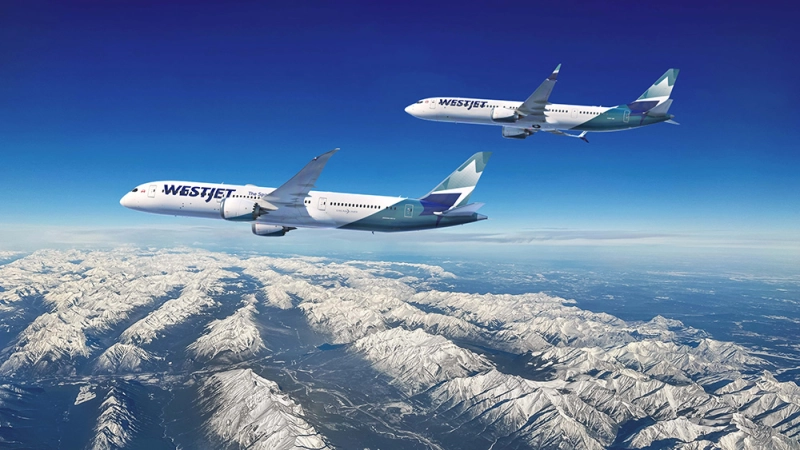WestJet’s Major Aircraft Acquisition
WestJet has announced a significant expansion of its fleet by ordering 67 Boeing aircraft, the largest purchase in the Canadian airline’s history. This move underlines the airline’s intent to broaden both its domestic and international reach, aiming to provide enhanced travel services spanning multiple continents.
The order comprises 60 Boeing 737-10 jets with options for 25 more, alongside 7 Boeing 787-9 Dreamliners, with options for an additional 4. These additions are set to double WestJet’s existing 787 Dreamliner fleet, aircraft renowned for their fuel efficiency and passenger comfort on long-haul routes linking North America with Europe, Asia, and Latin America.
Fleet Modernization and Efficiency
The Boeing 737-10 jets are recognized for their cost efficiency and low seat cost among single-aisle planes, making them ideal for shorter to medium-haul routes. Meanwhile, the 787 Dreamliners will elevate the quality of long-distance travel thanks to superior fuel economy and advanced passenger amenities.
This order positions WestJet with the largest firm order book among Canadian airlines, expanding its confirmed fleet count to 123 Boeing airplanes. Starting its journey in 1996 with just three Boeing 737s, WestJet now operates nearly 150 models of this workhorse aircraft, showcasing its growth over nearly three decades.
WestJet’s Historical Growth in Aviation
WestJet’s steady rise is a reflection of both strategic decisions and industry trends. The airline began with a modest fleet focusing on regional connectivity but has evolved into a major player with extensive domestic and international networks. Its embrace of Boeing aircraft has been consistent, highlighting a commitment to operating modern, reliable jets.
Since its inception in the mid-1990s, WestJet has leveraged the operational economics of efficient aircraft to offer competitive fares and expand service to popular vacation destinations and business hubs alike. This latest order aims not only to replace aging aircraft—the current fleet averages around 10 years old—but also to increase capacity in response to rising passenger demand.
Aircraft Models That Shaped Modern Air Travel
| Aircraft Model | Rôle | Caractéristiques principales |
|---|---|---|
| Boeing 737-10 | Single-aisle, short to medium haul | Lowest cost per seat; efficient for domestic routes |
| Boeing 787-9 Dreamliner | Wide-body, long-haul flights | Fuel efficiency; enhanced passenger comfort |
These models have been instrumental in shaping modern commercial aviation, combining technological advances that have lowered operating costs and improved the travel experience for passengers worldwide.
Impact on Tourism and Travel Connectivity
The fleet expansion by WestJet is poised to significantly influence international travel and tourism dynamics, particularly in markets served by its long-haul Dreamliners. Increased flight frequencies and new routes can stimulate tourism growth, linking more travelers to beach destinations, vibrant cities, and exotic regions.
Moreover, the deployment of newer jets with greater fuel efficiency contributes to more sustainable aviation practices, which are increasingly important considerations in tourism development globally.
Travel Destinations and Flight Networks
- Enhanced access to Europe, Asia, and Latin America via 787 Dreamliners
- Expanded domestic routes boosted by cost-efficient 737-10 jets
- Potential growth in sun and leisure travel destinations served by WestJet
Looking Ahead: The Future of Air Travel and Tourism
The aviation industry’s trajectory suggests continuous growth with demand for faster, more comfortable, and affordable travel options. Airlines like WestJet are responding by modernizing fleets and expanding service networks to meet evolving traveler expectations.
As long-haul aircraft like the Boeing 787 Dreamliner become more prevalent, destinations that depend on international visitors can anticipate increased activity, benefiting local economies and tourism-based businesses.
At the same time, the rise in air travel availability encourages not only leisure tourism but also wider business and cultural exchanges, fostering global connectivity in a way that can reshape tourism patterns for years to come.
Summary
WestJet’s record-breaking order for 67 Boeing aircraft marks a pivotal step in its growth strategy. By adding 60 Boeing 737-10s and 7 Boeing 787-9 Dreamliners to its fleet, the airline enhances its ability to serve both domestic and international markets efficiently. This modernization supports affordable travel and links Canadians more extensively to global destinations.
The airline’s history of expansion from a small fleet to a significant carrier illustrates the broader trends in aviation technology and service evolution. As the airline continues to expand, the connectivity of popular tourist destinations increases, ultimately benefiting the travel industry as a whole.
For travelers looking to explore coastal gateways, sunny beach towns, or bustling international hubs reachable by sea and air, access to flights like those provided by WestJet’s fleet expansion is critical. To complement this aerial connectivity, sailing enthusiasts and vacationers may find the GetBoat.com platform invaluable – an international marketplace offering a wide range of boat and yacht charters tailored to every taste and budget, perfectly linking air travel with waterborne adventures.

 WestJet Orders 67 New Boeing Aircraft to Strengthen Network">
WestJet Orders 67 New Boeing Aircraft to Strengthen Network">
